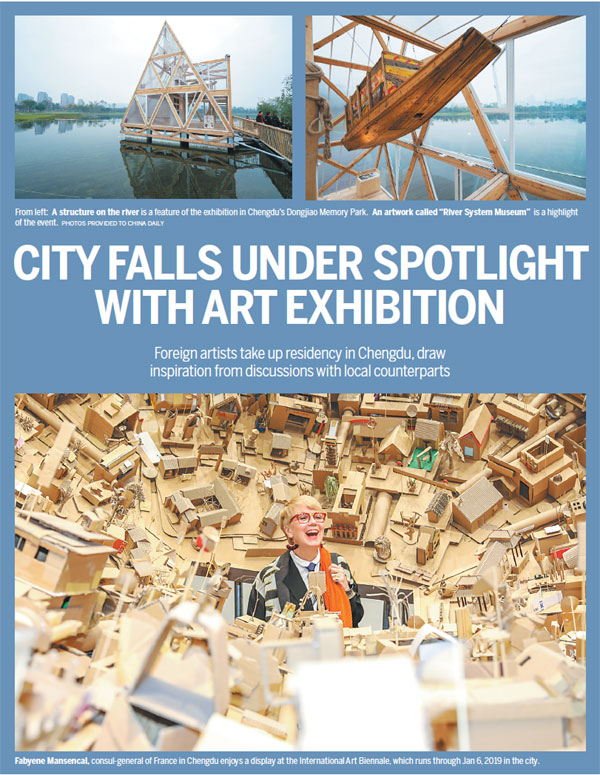CITY FALLS UNDER SPOTLIGHT WITH ART EXHIBITION
Foreign artists take up residency in Chengdu, draw inspiration from discussions with local counterparts
A cross-cultural exhibition in Chengdu has resulted in that city becoming a model of metropolitan progress in boosting opportunities for international cultural exchanges.
On Nov 2, the second International Art Biennale - Cosmopolis #1.5: Enlarged Intelligence kicked off in Chengdu Eastern Suburb Memory.
Sponsored by the Centre Georges Pompidou, Mao Jihong Art Foundation and Chengdu Media Group, the exhibition will last until Jan 6, 2019.
As a world famous modern art center named after former French president Georges Pompidou, Centre Georges Pompidou in Paris has gathered a large number of the world's leading collections.

"Cosmopolis" is a platform dedicated to global exhibitions and art research practices founded by Centre Georges Pompidou in 2016. The first biennale with that theme was held in Paris in 2017.
The exhibition presents hundreds of works by 60 artists or groups from more than 20 countries and regions around the world, covering international art exhibitions, on-site creation and music performances.
The event focuses on the impact of rapid changes happening in modern society and urban-rural relations and provides in-depth discussions for the transformation of cultural industry and public space, as well as the digital economy.
The exhibition invited a wide range of artists, philosophers, sociologists, writers, architects, musicians and interdisciplinary professionals, and the result has been a gathering of artists and artistic groups from all over the world, according to Laura Ning, CEO of Mao Jihong Art Foundation.
In addition to the main venue of the Eastern Suburb Memory, the event also set up sub-venues in representative public venues and city landmarks across Chengdu, including Jincheng Lake and Fanmate Creative Art Area, providing visitors with a visual feast from factories to waterside, from parks to bookstores, from cityscapes to villages.
During the exhibition, a large number of lectures, seminars and talks are being organized. Art films, music projects and educational activities such as children's art workshops will also be provided to the public.
A large number of the artworks exhibited during the event are embedded with distinctive Chengdu elements and the unique charm of Tianfu culture has become a source of inspiration for many artists, according to one official.
"For some domestic and foreign artists, this exhibition gave them the chance to visit Chengdu for the first time. When they arrived in Chengdu, they can tell the city is a huge treasure with so many artistic inspirations worth exploring," Ning said.
For many other exhibitions, the artworks were completed in advance, and setting up the exhibits simply involved moving the works from one place to another. But the biennale in Chengdu was totally different, she said.
In this case, Ning said, foreign artists spent two or three months of residence in Chengdu, exchanging their ideas with the local artistic professionals and architects, which helped new inspirations emerge.
"And the inspiration is still growing. In this process, the artist can constantly adjust his or her works, using new materials and new techniques and modifying the way the artwork is presented, adding a distinct Chengdu touch to their works," Ning said.
Artists Cao Minghao and Chen Jianjun employed images and sketches to show the vicissitudes of Chengdu; Cui Jie reserved Chengdu's architecture in oil paintings.
Ming Wong, a Singaporean artist living in Berlin, blended rap music with Sichuan Opera and science fiction in his work - Bamboo Spacecraft Story.
"There are countless things that make Chengdu well-known: pandas, Sichuan Opera, rap music, mask changing, science and technology..." Wong said.
Based on the inspiration he drew from Chengdu, Wong created a new genre of rap music video. With a core of science fiction, the work reflects all aspects of urban development - narrated by mask changing.
"In-Habit: Project Another Country", a large butterfly-shape installation created by two Filipino artists, Alfredo Aquilizan and Isabel Aquilizan, caught visitors' attention at the exhibition. With waste paper boxes and cardboard, they built up the work to show the ideal residence in their understanding.
"A part of the inspiration for this work comes from the circular-shaped urban planning of Chengdu," they said.
In this biennial, the works of Chengdu local artists are also a highlight. They brought new types of installation and video works to the exhibition, showcasing the strength of Chengdu's contemporary art.
The organizer said that the biennale is not only a visual carnival for citizens, but also an opportunity for the world to recognize Chengdu through art.
Thanks to the solid art foundation accumulated in its long history and the interaction between traditional and contemporary art, Chengdu has been known as one of "the top three leaders of Chinese art" after Beijing and Shanghai, according to officials.

(China Daily 11/29/2018 page12)














